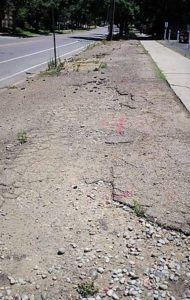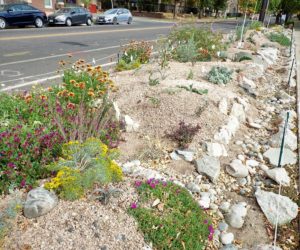By Lisa Olsen
The following article originally appeared in the Spring 2021 issue of the Wild Ones Journal and is reprinted with their permission and the authors.
North Capitol Hill neighborhood residents have noticed a lot of activity at the Denver Turnverein. Founded in 1865, the Denver Turnverein is a member-supported nonprofit focused on the educational, social, and physical benefits of dancing. In the age of COVID-19, the building is quiet, but the Greenverein Garden on the north side of the property is teeming with life.
The Greenverein Garden was proposed by volunteers from Uptown on the Hill, a community organization that connects residents and businesses and improves the neighborhood’s livability. They saw an opportunity to beautify the neighborhood by transforming the asphalt-covered strip at the corner of 16th Street and Clarkson into a low-maintenance landscape that would be enjoyed by residents and visitors. Late in 2018, fundraising began in earnest in collaboration with the Denver Turnverein Board president. In Spring 2019, contractors removed the asphalt and planted three street trees.
In June 2019, volunteers planted an assortment of low water shrubs, perennials and grasses, all tried and true plants for Colorado gardens. Since the native soil is heavily compacted clay, volunteers used pick axes to break up the ground. Christine Gust, a member of both the Turnverein and Wild Ones, is schooled in permaculture, volunteered on planting day, and thought that the garden could also be a welcome home to native plants that would be better suited to the garden’s challenging conditions.
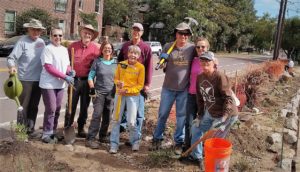
Volunteers pose after a Fall 2019 workday on the new neighborhood garden. Photo by Christine Gust.
Challenges of Planting a Hell Strip
The Greenverein Garden is the epitome of a hell strip: sandwiched between an asphalt parking lot and a street, in full sun, with lifeless, compacted soil. The summer of 2019 was relentlessly hot; volunteers worked to keep the garden alive, hand watering the plants almost daily. Then, in August, a torrential downpour brought disaster: Clarkson and 16th swelled with stormwater, submerging the garden and washing away all of the mulch and much of the soil.
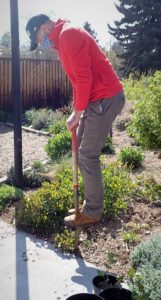
Colorado four o’clock (Mirabilis multiflora), a transplanted seedling from John Murgel’s garden who had hosted a Wild Ones tour in fall 2019, flourishes in the Greenverein Garden. The volunteer who planted it thought she had killed it as most of the foliage snapped during planting. Apparently, the plant took that setback as a personal challenge and sprang out of the ground, perfectly content with the sun, the heat and the poor soil. Photo by Lisa Olsen
In early September, Gust arranged a meeting between volunteers from the Denver Turnverein, Uptown on the Hill to discuss goals for the garden and potential steps forward. Wild Ones elected to invest time and resources into this project because of its public location, grassroots support, and potential as a demonstration garden.
When outlining the goals of the garden, aesthetic appeal topped the list. The initial intent of the garden was to beautify the neighborhood: the garden needed to be pretty and offer year-round interest. In practical terms, the garden also had to be low cost, low maintenance and functional. Counseled by Wild Ones, adding native plants to the garden fulfilled all of the above criteria and boosted its ecological value. Selecting native plants that thrive under the challenging conditions makes the garden more resilient and makes it more inviting for native bees, butterflies, birds, and other wildlife.
The Water Challenge
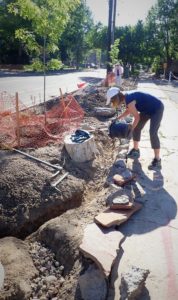
Volunteers dig and fill rainwater catchment trenches in the Greenverein Garden. Photo by Lisa Olsen
The biggest blessing and curse of the garden is water since the garden relies entirely on manual watering. Under these circumstances, rain would be welcome, but given the vast area of the Turnverein’s roof and the adjacent impermeable parking lot, the potential volume of water sheeting across the garden and eroding the soil was significant.
Altering the topography of the garden enhanced its potential to both capture rainwater and mitigate soil erosion. Check dams installed adjacent to the sidewalk, and the street slowed the flow of water into and out of the garden, and a network of trenches of varying depths filled with rock slowed and directed the flow of water through the garden, giving it time to infiltrate. With winter on the horizon, volunteers, organized by Gust as project manager, agreed to move forward with a redesign and planting of the western third of the garden to test the design’s feasibility, viability and appeal.
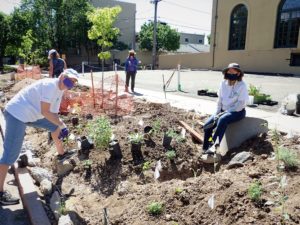
Despite COVID-19, volunteers came out with masks and socially distanced while planting the Greenverein Garden. Photo by Lisa Olsen.
In late September, volunteers took up pickaxes and shovels. They got to work digging trenches, building berms and “planting” urbanite, chunks of broken concrete that would serve as the primary hardscape element in the garden. Cement, the key ingredient of concrete, has a massive carbon footprint at 8% of the world’s carbon dioxide (CO2) emissions. But sourcing concrete locally compounded the garden’s potential to sequester carbon and help mitigate the effects of climate change.
Adding to the hardscape elements, volunteers collected free boulders, river rock, cobbles, pea gravel and weathered cottonwood stumps off Nextdoor and Craigslist. Others dug up plants that had survived the summer heat. Some were transplanted into the new berms and others were potted up and tended over the winter. With limited funds, a handful of shrubs and perennials were purchased at local nurseries and other native plants were donated by Wild Ones members. Almost all of the plants planted in October 2019 survived the winter. These Colorado and regional natives were flourishing and attracting hummingbirds to the garden by summer.
Blue flax (Linum lewisii)
Dwarf rabbitbrush (Ericameria nauseosus)
Swamp milkweed (Asclepias incarnata)
Butterfly weed (Asclepias tuberosa)
Prairie sage (Artemisia ludoviciana)
Red birds in a tree (Scrophularia macrantha)
Desert beardtongue (Penstemon pseudospectabilis)
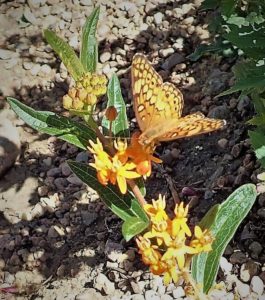
A variegated fritillary on butterfly weed (Asclepias tuberosa) at the new Denver demonstration garden. Photo by Lisa Olsen.
Only one of the three street trees planted in spring 2019 survived the summer; two replacement trees were planted by Denver’s City Forestry “Be a Smart Ash” program in November. The city initially offered to plant trees native to Asia, but a letter from Wild Ones asking for trees more in line with the garden’s goal of supporting wildlife yielded substitutions of North American native honey locust (Gleditsia triacanthos var. inermis) and scarlet oak (Quercus coccinea).
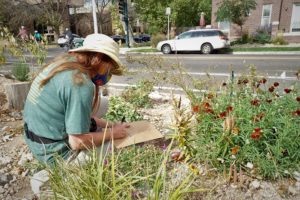
Lisa Olsen collects native seed in the Greenverein Garden in October. Photo by Christine Gust.
The Design is Expanded
The success of the pilot phase encouraged an expansion of the design. In spite of, and in some cases because of the COVID-19 pandemic, volunteers made rapid progress. Materials were more readily available as many who were stuck at home undertook yard improvement projects, and volunteers whose work schedules were disrupted had more time to dedicate toward installation. Following the lifting of the Stay-at-Home order, volunteers donned masks and showed up to work — at safe distances — in the garden. Grants covered the cost of some plants from local nurseries and were combined with donations of materials and labor, as well as more shrubs and perennials. As expected, a few plants struggled and succumbed to the heat as it’s never optimal to plant a garden in July. Many thrived, including the great basin/big sagebrush (Artemisia tridentata), Mojave sage (Salvia pachyphylla), littleleaf mountain mahogany (Cercocarpus intricatus) and fringed sage (Artemisia frigida). The blanket flower (Gaillardia aristata) and the annual Rocky Mountain bee plant (Cleome serrulata) completely ignored the “sleep, creep, leap” adage and bloomed profusely throughout the summer and well into early September snow.
While it is difficult to build an ideal habitat adjacent to a city street, certain elements, like host plants, go a long way toward inviting wildlife to visit and possibly reproduce. The cottonwood stumps were introduced into the design as both aesthetic and ecological features. Cottonwoods are native keystone species of riparian corridors on the plains, but they are a poor choice for urban settings. “Planting” cottonwood stumps in the garden honors their immense ecological value without the mess and hazard of living trees. Placed near milkweed and other host plants, the cracks and crevices in the deadwood provide shelter for caterpillars to pupate. The hope is to foster youth and adult engagement with nature in the garden through community science programs like Native Bee Watch and the Monarch Larva Monitoring Project.
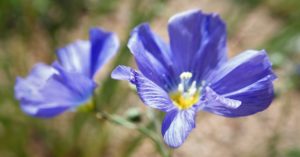
Wild blue flax (Linum lewisii). Photo by Lisa Olsen.
It’s always best to select the “right plant for the right place,” to select plants for the soil and exposure that you have rather than altering the soil by tilling or amending and stressing plants unnecessarily. In order to optimize the Greenverein Garden’s ability to conserve water and build soil over time, relatively minor adjustments to the topography were deemed necessary. While composed mostly of native clay, the low berms, amended with looser fill dirt, squeegee and pea gravel, provide sufficient drainage for cacti and other plants like penstemons that are accustomed to growing on slopes. The berms’ added height enabled the addition of small sections of crevice gardens, which showcase diminutive cacti, succulents and heat-tolerant rock garden plants. While working in the garden, the feedback expressed by passersby to volunteers has been refreshingly positive. People love how the garden looks like Colorado, how it reflects this state’s exceptional rugged beauty.
- The Greenverein Garden before June 2018 Photo by Judy Hopper.
- The Greenverein Garden after October 2020. Photo by Lisa Olsen
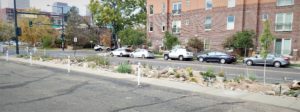
The Greenverein Garden after (October 2020) shows the resilience of native plants. Photos by Lisa Olsen.
It’s hard not to laugh when people say, “I can’t wait to see how it looks when it’s done.” That’s not how gardens work. Gardens are alive and ever-changing. Cultural landscape historian and writer Mac Griswold describe gardening as “the slowest of the performing arts.” As such, the Greenverein Garden fulfills Turnverein’s mission to showcase and promote the practice and performance of the arts — those that maintain a sound body and mind — and is a beautiful and fitting addition to the North Capitol Hill neighborhood.
In March of 2021 (Lisa Olsen, Christine Gust and Judy Hopper) were awarded Neighborhood Star awards by the Denver Inter-Neighborhood Cooperation. The awards recognized service to the community in 2020. https://www.denverinc.org/2020-inc-awards/
In 2020 Front Range Wild Ones and Judy worked untold hours to solicit financial support, build berms, dig trenches, add boulders, and plant. They obtained unwanted materials, such as broken concrete, tree stumps, pea gravel, and native plants. Using Lisa’s design, the result is a beautiful garden on the site, one that already lures bees, butterflies, and even a rabbit or two, saves water and draws appreciative comments from passersby. It’s a better place to live by dramatically showing the benefits of using native plants in city gardens.
About the Author
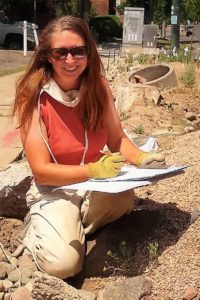
Lisa Olsen working on the garden design. Photo by Christine Gust.
Lisa Olsen is Wild Ones Chapter Liaison, supporting a growing number of chapters across the country. If you are interested in founding a Wild Ones chapter in your community, please contact Start a Wild Ones Seedling Chapter. Lisa volunteers for the Wild Ones Front Range (Colorado) chapter and notes that this demonstration garden has spurred community interest in converting Denver’s downtown hell strips into beautiful viable habitat.
***
Each author appearing herein retains original copyright. Right to reproduce or disseminate all material herein, including to Columbia University Library’s CAUSEWAY Project, is otherwise reserved by ELA. Please contact ELA for permission to reprint.
Mention of products is not intended to constitute endorsement. Opinions expressed in this newsletter article do not necessarily represent those of ELA’s directors, staff, or members.

